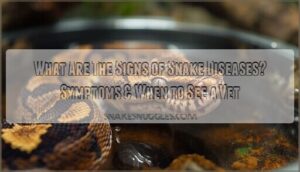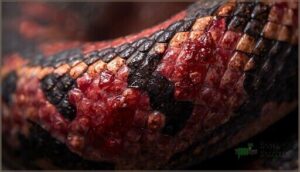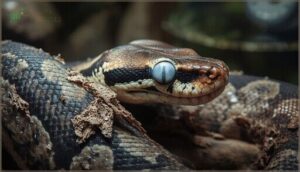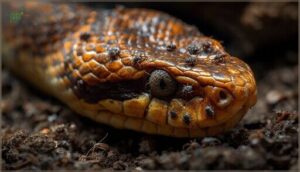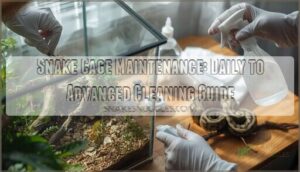This site is supported by our readers. We may earn a commission, at no cost to you, if you purchase through links.
Your ball python hasn’t eaten in three weeks, and you’ve noticed she’s spending more time soaking in her water bowl than usual. While some behavioral quirks are normal, others serve as critical warning signs that demand your attention.
Snakes can’t vocalize discomfort or pain the way mammals do, which means their bodies communicate through subtle physical changes, behavioral shifts, and visible symptoms that many keepers overlook until conditions become severe.
Understanding the signs of snake diseases transforms you from a passive observer into an active guardian capable of detecting metabolic disorders, respiratory infections, parasitic infestations, and dermatological issues before they escalate into life-threatening emergencies.
Recognizing early indicators like abnormal shedding patterns, unusual mouth discharge, persistent lethargy, or skin changes can mean the difference between a simple intervention and irreversible organ damage.
Table Of Contents
- Key Takeaways
- What Are The Signs of Snake Diseases?
- Recognizing Skin and Scale Problems in Snakes
- Common Respiratory Disease Symptoms in Snakes
- Detecting Internal and External Parasite Infections
- When to Seek Veterinary Care for Snake Illness
- Frequently Asked Questions (FAQs)
- How can I tell if my snake is sick?
- What are some specific symptoms of common illnesses in snakes?
- Why is shedding a concern for snake health?
- What are some signs of respiratory problems in snakes?
- What are some behavioral changes that may indicate snake illness?
- When should I seek veterinary care for my snake?
- How do I tell if my snake is unhealthy?
- How to tell if a snake has an infection?
- How do snakes act when sick?
- What does snake fungal disease look like?
- Conclusion
Key Takeaways
- Your snake’s inability to vocalize pain means you must recognize clinical warning signs like respiratory distress, abnormal shedding patterns, skin lesions, or feeding refusal before conditions progress to life-threatening emergencies requiring intensive veterinary intervention.
- Respiratory infections manifest through open-mouth breathing, nasal discharge, and audible wheezing that demand immediate veterinary assessment, as bacterial, viral, or fungal pathogens compromise pulmonary function rapidly and can progress to fatal pneumonia without prompt antimicrobial therapy.
- Skin abnormalities including scale rot, persistent blisters, or purulent discharge signal bacterial dermatitis that progresses from superficial infections to systemic septicemia without appropriate topical antiseptic care, while incomplete sheds indicate environmental deficiencies or metabolic disorders affecting your snake’s overall health.
- Documenting symptom onset dates, environmental parameters, behavioral changes, and photographic evidence of physical abnormalities provides your reptile veterinarian with critical diagnostic information that enables accurate disease identification and appropriate treatment protocols before reversible conditions become fatal.
What Are The Signs of Snake Diseases?
Recognizing early signs of disease in your snake can mean the difference between a minor health issue and a life-threatening emergency. Captive reptiles often hide symptoms until conditions become severe, making careful observation critical to their survival.
Early disease detection in captive snakes is critical because reptiles hide symptoms until conditions become severe or life-threatening
The following clinical signs warrant immediate attention, as they indicate potential bacterial infections, parasitic infestations, or environmental stressors requiring veterinary intervention.
Lack of Appetite and Lethargy
A sudden drop in appetite paired with lethargy ranks among the most common signs of illness in your snake, signaling potential metabolic disorders, stress factors, or nutrition deficiencies. These behavioral changes, whether from infection, dehydration, or environmental shifts, demand your attention as reptile health issues rarely resolve independently.
Recognizing early warning signs of feeding refusal helps you distinguish temporary stress from serious illness requiring veterinary intervention.
Document when these snake diseases first appeared to aid your veterinarian’s assessment and support appetite stimulation strategies. Understanding the importance of scientific study summaries can help identify underlying causes of these health issues.
Abnormal Shedding or Dysecdysis
Incomplete sheds, or dysecdysis, often signal inadequate humidity or underlying metabolic imbalances in your snake. Retained eye caps, tail segments, or body patches indicate environmental shortfalls or systemic illness. These shedding problems stem from causes like improper snake humidity, nutritional deficiencies, or parasitism, compromising skin health and overall reptile well-being if unaddressed.
- Retained shed on eyes or tail suggests humidity levels need adjustment for proper pet snake care
- Chronic shedding difficulties may accompany metabolic disorders requiring veterinary blood work
- Regular enclosure monitoring prevents dysecdysis and promotes long-term snake health
Understanding dictionary search tools can help identify terms related to snake diseases and symptoms.
Respiratory Distress (Wheezing, Open-Mouth Breathing)
Wheezing, audible breath sounds, or open-mouth breathing signal respiratory disease, often progressing to pneumonia if untreated. These respiratory infections manifest with nasal discharge, lethargy, and labored respirations, indicating airway obstruction or lung infection.
Breathing difficulty in your snake demands immediate veterinary assessment, as bacterial, viral, or fungal pathogens compromise pulmonary function rapidly. Recognizing these respiratory issues early prevents progression to life-threatening respiratory failure in captive reptiles.
Skin infections often accompany respiratory distress, so watch for early signs of snake skin infections like redness around scales or unusual swelling during your assessment.
Skin Changes (Redness, Blisters, Scale Rot)
Redness around scale margins, blisters that won’t heal, or foul discharge indicate skin infections and scale rot, often caused by excessive moisture, poor hygiene, or bacterial dermatitis. You’ll notice erythema spreading beyond the initial lesion, macerated skin texture, and sometimes necrotic tissue with a characteristic odor.
These skin abnormalities demand immediate intervention, as superficial infections progress rapidly to systemic septicemia without appropriate topical antiseptic care and systemic antibiotics.
Unusual Mouth Discharge or Swelling
Purulent discharge, swelling along the gingival margin, or foul odor from your snake’s oral cavity signal infectious stomatitis, commonly called mouth rot, which stems from bacterial infection.
This condition, often linked to septicemia or respiratory disease, manifests as bright red or yellow pus-like material, oral abscesses, and inflamed tissue requiring immediate veterinary evaluation before systemic complications develop.
Visible External Parasites (Mites, Ticks)
Tiny black specks moving across your snake’s scales, crusty deposits near the eyes, or visible ticks embedded in skin folds reveal ectoparasitic infestations that demand prompt parasite control interventions.
Regular health monitoring helps you catch these issues early, and understanding common snake health problems ensures you’re prepared to respond effectively.
- Mite infestations cause excessive rubbing, translucent crusts, and behavioral changes requiring veterinary-prescribed acaricides and rigorous reptile hygiene protocols.
- Tick removal must be performed carefully to prevent mouthpart retention and secondary infection.
- External symptoms include localized swelling, anemia, and skin irritation that may promote bacterial colonization.
- Parasite control extends to environmental decontamination, quarantine procedures, and routine parasitology screening to eliminate snake parasites and reptile parasites before systemic complications or intestinal parasites emerge.
Diarrhea, Regurgitation, or Weight Loss
Gastrointestinal issues manifest as watery stools, undigested prey expelled shortly after feeding, or progressive emaciation despite maintained appetite, signaling intestinal parasites, cryptosporidiosis, or systemic reptile disease requiring parasitology workup.
Finding a qualified reptile veterinarian experienced in snake care quickly becomes critical when these symptoms appear, as delayed treatment often worsens prognosis.
Dehydration signs, feeding problems, and muscle wasting demand veterinary care to rule out infectious stomatitis complications or organ dysfunction.
You’ll need fecal testing, bloodwork, and proper snake nutrition adjustments during reptile disease treatment protocols.
Recognizing Skin and Scale Problems in Snakes
Your snake’s skin acts as its first line of defense against infection, making it a critical indicator of overall health. When environmental conditions aren’t right or hygiene falters, skin and scale problems can develop quickly, ranging from localized infections to systemic issues that compromise your pet’s wellbeing.
Understanding what these problems look like helps you catch them early, when treatment is most effective.
Signs of Skin Infections and Scale Rot
When your snake’s scales develop red, swollen patches with ulcerations or blisters, you’re likely witnessing bacterial dermatitis or scale rot, serious skin lesions that demand immediate attention.
Watch for purulent discharge, necrotic tissue turning dark or black, and foul odors emanating from affected areas—these skin abnormalities signal fungal infections or scale damage compromising your snake’s health and requiring prompt veterinary intervention.
Shedding Issues and Retained Shed
When your snake can’t shed completely in one piece, you’re observing dysecdysis, a shedding problem signaling reptile health concerns tied to humidity control deficiencies or underlying infectious diseases. Retained skin patches, especially around the eyes and tail, create skin irritation and potential infection sites that compromise reptile disease management and overall wellness.
Watch for these dysecdysis causes requiring immediate correction:
- Cloudy, blue-tinted eyes with stuck spectacle scales obstructing vision and causing ocular tissue constriction
- Visible patches of older skin adhering to body segments, tail tips, or toes despite completed shed cycles
- Repeated incomplete sheds indicating improper environmental temperature, inadequate hydration, or systemic illness affecting normal ecdysis
Address husbandry factors immediately—boosting enclosure humidity, providing moisture boxes, ensuring proper hydration—to prevent retained skin from progressing to eye infections or localized dermatitis, and consult your reptile veterinarian if shedding issues persist despite environmental corrections.
Identifying Mite and Tick Infestations
You’ll spot mite and tick infestations through visible dark specks crawling across scales, tiny moving residues in bedding substrate, or engorged oval ticks attached near vulnerable areas like eyes and cloaca.
Mite removal and tick prevention require immediate parasite control addressing both your snake and enclosure, preventing infectious diseases and parasitic infections that compromise reptile health through anemia, stress, and secondary dermatitis requiring thorough reptile hygiene protocols.
Common Respiratory Disease Symptoms in Snakes
Respiratory infections rank among the most common health problems you’ll encounter in captive snakes, often developing when environmental conditions don’t meet your snake’s specific requirements.
You can identify these infections early by watching for several distinctive clinical signs that affect your snake’s breathing, energy levels, and overall behavior.
The following symptoms indicate respiratory disease and warrant immediate veterinary consultation to prevent progression to more serious conditions like pneumonia or septicemia.
Nasal Discharge and Excess Mucus
When your snake displays persistent nasal discharge beyond one to two weeks, you’re observing a hallmark of respiratory disease that warrants clinical attention. Respiratory infections, including those complicated by infectious stomatitis, produce excess secretion that may appear clear, cloudy, or discolored depending on the pathogen involved. Nasal obstruction from mucus production can compromise breathing, particularly when sinus infections develop. Veterinary diagnostics in reptile medicine often employ cytology and culture to identify causative organisms, guiding appropriate antimicrobial therapy.
Monitor these key indicators:
- Persistent or recurring discharge from one or both nares
- Mucus color changes from clear to yellow, green, or blood-tinged
- Sneezing or snorting attempts to clear blocked nasal passages
- Visible crusting or dried secretions around the nostrils
- Increased respiratory effort accompanying nasal obstruction
Respiratory issues in captive snakes frequently stem from suboptimal husbandry conditions, including inadequate temperature gradients or excessive humidity, which predispose animals to bacterial, viral, or fungal colonization of the respiratory tract.
Open-Mouth Breathing and Wheezing
When your snake displays open-mouth breathing at rest, you’re witnessing a critical indicator of respiratory distress requiring immediate intervention.
Wheezing sounds emerge when nasal congestion or airway obstruction restrict normal airflow, forcing snakes to breathe through their mouths—an abnormal behavior in healthy serpents.
These respiratory issues can signal bacterial or viral respiratory infections, occasionally complicated by infectious stomatitis, and in rare cases may suggest inclusion body disease.
Lethargy Linked to Respiratory Illness
Reduced activity and reluctance to move accompany respiratory infections because labored breathing depletes energy reserves your snake needs for normal behavior. Snake pneumonia progresses from mild listlessness to complete immobility, with breathing difficulties worsening as bacterial infections, fungal pathogens, or reptile viruses compromise lung function and overall health.
You’ll notice decreased appetite alongside this lethargy, as respiratory failure makes swallowing difficult and dangerous.
Detecting Internal and External Parasite Infections
Parasitic infections, both internal and external, are among the most common health challenges you’ll encounter in captive snakes, often remaining undetected until clinical signs become severe. Intestinal parasites like nematodes and protozoans can cause progressive weight loss and digestive disturbances, while external parasites such as snake mites (Ophionyssus natricis) and ticks create visible irritation and potential secondary infections.
Recognizing the distinct symptoms of each parasitic category allows you to intervene early and prevent complications that could compromise your snake’s immune system.
Symptoms of Intestinal Parasites (Diarrhea, Weight Loss)
When intestinal parasites invade your snake’s digestive tract, disrupting the parasite life cycle becomes critical before severe digestive health complications develop. Fecal analysis confirms parasitic infections like protozoal diseases, which can progress to intestinal blockage if untreated, mimicking signs of inclusion body disease in late-stage cases.
Watch for these warning signs:
- Persistent diarrhea with watery, malodorous feces indicating parasite burden
- Progressive weight loss despite maintaining normal feeding schedules
- Pale or mucus-laden stool suggesting malabsorption from damaged intestinal lining
- Visible worm segments near the cloaca in severe parasitic infections
Identifying External Parasites on The Body
Careful parasite inspection reveals mites as dark specks moving across scales, while ticks embed themselves beneath ventral plates, creating visible bumps with protruding legs. External infestation often triggers skin irritation and abnormal shedding patterns resembling dysecdysis, complicating reptile parasite control efforts.
Effective mite removal and tick control require prompt veterinary intervention.
| Parasite Type | Visual Identification |
|---|---|
| Mites | Tiny moving specks on skin surface, concentrated around eyes and heat pits |
| Ticks | Hard bumps with visible legs, commonly attached between scales or near cloaca |
| Secondary Signs | Reddened skin, premature scale rot, excessive soaking behavior indicating discomfort |
Signs of Parasitic Breathing Difficulties
Open-mouth breathing at rest, accompanied by wheezing or nasal discharge, signals potential respiratory parasitism requiring immediate parasite diagnosis. Lungworms and other internal parasites cause airway obstruction, progressing from breathing difficulty to snake pneumonia if untreated.
You’ll notice gasping episodes, lethargy, and mucous accumulation—critical respiratory issues demanding veterinary evaluation to prevent respiratory failure and restore reptile health through targeted antiparasitic therapy.
When to Seek Veterinary Care for Snake Illness
Knowing when to call your reptile veterinarian can mean the difference between a treatable condition and a life-threatening emergency, as many snake diseases progress rapidly once clinical signs become apparent. You’ll need to recognize which symptoms demand immediate professional intervention, understand how to properly document your observations for diagnostic purposes, and locate a qualified exotic animal practitioner experienced in ophidian medicine.
The following sections outline critical warning signs, effective symptom tracking methods, and criteria for selecting appropriate veterinary care for your snake.
Emergency Signs Requiring Immediate Attention
Some clinical signs demand immediate veterinary intervention, as delays can prove fatal. Severe trauma with visible hemorrhage, acute dehydration presenting as sunken eyes and diminished skin turgor, respiratory failure manifested by labored open-mouth breathing, and collapse with unresponsiveness constitute critical symptoms requiring emergency care.
Conditions such as septicemia, inclusion body disease, and late-stage respiratory issues can rapidly deteriorate, making prompt recognition of these signs of illness essential for your snake’s survival and ideal snake health.
How to Document Symptoms for The Vet
Accurate veterinary communication begins with detailed symptom logging and record keeping before your appointment. A thorough medical history with specific observations allows your reptile veterinarian to perform efficient disease diagnosis and deliver appropriate veterinary care for snakes. Consider documenting:
- Onset date and duration of each sign of illness, including behavioral changes in appetite, activity, and shedding cycles
- High-resolution photographs showing progression of skin lesions, scale abnormalities, or oral discharge with scale reference
- Environmental parameters such as temperature gradients, humidity levels, and substrate type during symptom development
These diagnostic tools help identify snake disease symptoms and distinguish between husbandry-related issues and infectious processes requiring treatment.
Choosing a Qualified Reptile Veterinarian
Selecting a reptile veterinarian requires verification of formal training in veterinary medicine, board certification in exotic animal specialties, and species expertise with snakes. You should confirm the practice maintains in-house diagnostic tools, current reptile care and maintenance protocols, and emergency preparedness for critical cases.
Strong veterinary credentials, documented reptile experience, and thorough animal health management capabilities guarantee superior veterinary care for snakes when disease signs appear.
Frequently Asked Questions (FAQs)
How can I tell if my snake is sick?
Is your snake acting off? Watch for reduced appetite, lethargy, abnormal shedding, respiratory noises like wheezing, unusual mouth discharge, or skin changes—these signs of illness demand prompt veterinary care and thorough health checks.
What are some specific symptoms of common illnesses in snakes?
Common signs include nasal discharge, open-mouth breathing, scale rot with redness and blistering, mouth swelling with mucus, visible mites or ticks, diarrhea, regurgitation, and sudden weight loss requiring immediate reptile veterinary attention.
Why is shedding a concern for snake health?
Dysecdysis causes skin lesions and traps debris under retained shed, signaling deeper problems like dehydration, poor humidity control, or nutritional deficiencies affecting snake health.
Shedding patterns thus serve as a critical diagnostic window for reptile diseases, highlighting the importance of monitoring these processes to ensure overall well-being.
What are some signs of respiratory problems in snakes?
You’ll notice nasal discharge, open-mouth breathing, and audible wheezing or crackling sounds when your snake has respiratory issues.
These breathing difficulties, often paired with lethargy, signal a potential respiratory infection requiring prompt veterinary attention.
What are some behavioral changes that may indicate snake illness?
Like a canary in a coal mine, behavioral changes often signal underlying health issues. Decreased activity levels, refusal to eat, increased hiding, lethargy beyond normal patterns, and altered handler interactions all indicate your snake needs a reptile veterinarian’s evaluation.
When should I seek veterinary care for my snake?
You should seek veterinary care when your snake shows respiratory distress, refuses food for over seven days, displays skin lesions or mouth swelling, exhibits lethargy with open-mouth breathing, or demonstrates any sudden behavioral changes.
How do I tell if my snake is unhealthy?
You’ll spot trouble when your snake shows reduced appetite, unusual lethargy, labored breathing, skin lesions, abnormal feces, or retained shed—these common snake diseases demand prompt veterinary guidance and thorough health checks to prevent serious complications.
How to tell if a snake has an infection?
Your snake has an infection if you observe nasal discharge, open-mouth breathing, skin swelling, lethargy, or oral ulcerations.
Respiratory infection, bacterial infections, and septicemia require immediate veterinary care to prevent systemic complications.
How do snakes act when sick?
When illness strikes, you’ll notice your snake becomes unusually lethargic, refuses food, and withdraws from interaction—clear behavioral changes signaling compromised reptile health. These signs demand immediate attention to restore proper snake wellness and prevent further disease progression.
What does snake fungal disease look like?
You’ll notice crusty, raised patches or white powdery fungal growth on your snake’s skin, often accompanied by redness, scale damage, and lesions around the mouth—clear signs requiring prompt veterinary attention.
Conclusion
Many keepers believe snakes naturally hide illness until it’s too late, but this isn’t entirely accurate—they display signs of snake diseases continuously through behavioral deviations, physical abnormalities, and feeding irregularities that demand your trained observation.
Your vigilance transforms these subtle communications into actionable interventions, bridging the gap between early detection and irreversible decline.
When you document symptoms methodically and consult qualified reptile veterinarians promptly, you provide your snake the critical advantage of timely medical intervention that preserves both longevity and quality of life.
- https://lafeber.com/vet/respiratory-disease-in-snakes/
- https://wpvet.com/reptile-rounds/respiratory-infections/
- https://www.youtube.com/watch?v=BkxgHcR6AJ4
- https://www.petmd.com/reptile/conditions/respiratory/respiratory-infections-reptiles
- https://www.birdexoticsvet.com/post/snake-viral-infections-symptoms

